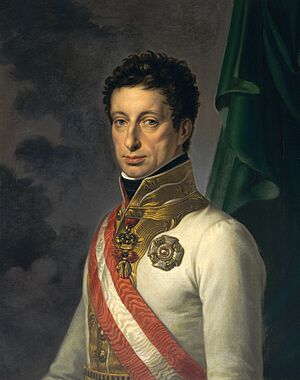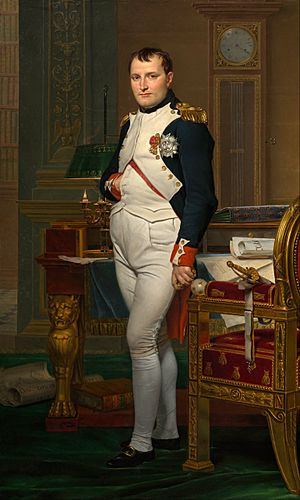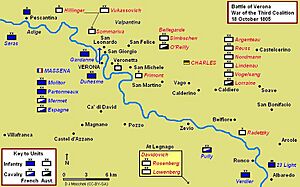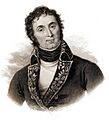Battle of Verona (1805) facts for kids
Quick facts for kids Battle of Verona (1805) |
|||||||
|---|---|---|---|---|---|---|---|
| Part of the War of the Third Coalition | |||||||
 The French launched their attack across the lightly guarded Ponte di Castelvecchio. |
|||||||
|
|||||||
| Belligerents | |||||||
| Commanders and leaders | |||||||
| Strength | |||||||
| 13 battalions 15 guns |
6 battalions 1 squadron 12 guns |
||||||
| Casualties and losses | |||||||
| 323-450 | 1,152-1,622 4 guns lost |
||||||
The Battle of Verona happened on October 18, 1805. It was a fight between the French Army led by André Masséna and an Austrian army. The Austrian army was under the command of Archduke Charles, Duke of Teschen. By the end of the day, the French took control of a key area. This area was on the east side of the Adige River. They pushed back the Austrian troops led by Josef Philipp Vukassovich. This battle took place near Verona in northern Italy. It was part of the War of the Third Coalition, which was a bigger part of the Napoleonic Wars.
In the fall of 1805, Emperor Napoleon had a big plan. He wanted his powerful French army, called the Grande Armée, to defeat the Austrian Empire army in southern Germany. Napoleon hoped to win the war quickly in the Danube valley. To help with this, Napoleon wanted Masséna to keep Archduke Charles' large army busy in Italy. This would stop them from helping the Austrians in Germany.
For Masséna to fight his enemies, he needed to cross the Adige River. He had to set up a "bridgehead," which is a safe area on the other side of a river. During the battle, the French attacked across the river. They cleared two suburbs and took over some high ground. The Austrians lost many more soldiers than the French. This battle was important. It set the stage for another big fight, the Battle of Caldiero, which happened later in October.
Contents
Why the Battle Happened
Austrian Battle Plans
On September 5, 1805, Austrian leaders made their final war plan. These leaders included Feldmarschall Archduke Charles. The plan was similar to an earlier one. But one general, Anton Mayer von Heldensfeld, convinced them to send more troops to Germany. This was because General Karl Mack von Leiberich wanted to invade Bavaria.
The first plan put 120,000 soldiers in Italy. The new plan reduced this to 90,000. About 30,000 soldiers were sent to Germany.
Archduke Charles did not agree with Mack's aggressive plan. He told Emperor Francis I that Mack was making a big mistake. But the emperor let Mack go ahead. Charles feared the worst in Bavaria. So, he decided to defend his positions in Italy. He knew he had more soldiers than Masséna.
Charles placed 22,000 troops in the Italian Tyrol. This was north of Rivoli Veronese. He put 40,000 soldiers along the east bank of the Adige River. This line stretched from Verona to Legnago. He also kept a group of 30,000 soldiers ready at Caldiero. General Heinrich von Bellegarde watched Verona. General Josef Vukassovich's troops were northeast of the city. Other divisions were to the east. General Paul Davidovich defended the Adige near Legnago.
French Battle Plans
In early August 1805, Napoleon changed his mind. He stopped planning to invade Great Britain. Instead, he decided to move his army to southern Germany. His goal was to defeat the Austrian army there. He hoped to reach Vienna, the Austrian capital, by November. He wanted to do this before the Russian army arrived. Napoleon sent 194,000 soldiers to Germany. These included his main army groups, cavalry, and allies. This army was very well-trained and organized. It was one of the best armies Napoleon ever led. On August 26, he ordered them to march. A month later, they were crossing the Rhine river.
Napoleon knew the Austrians had their biggest army in Italy. He wanted to make sure this army could not help in Germany. Masséna's French army in Italy had only 48,000 soldiers. So, Masséna first focused on defending his positions. In 1805, the Adige River was the border. It separated French Lombardy from Austrian Venetia. Masséna placed 5,000 soldiers in forts on the west side of the Adige. These forts were in Verona, Legnago, Peschiera del Garda, and Mantua.
At first, Masséna held the Adige line with three infantry divisions. General Jean-Mathieu Seras watched the Austrians from Rivoli in the north. General Gaspard Amédée Gardanne held Verona. General Jean-Antoine Verdier defended the Adige near Legnago. Following Napoleon's orders, Masséna started gathering his army. He planned to bring his main attack force near Verona. This force included five infantry and two cavalry divisions. He also planned for Verdier's division to distract the Austrians further south.
To gain time, Napoleon allowed Masséna to suggest a truce. Masséna did, and Archduke Charles agreed. On September 29, they made a deal. Fighting would not start until six days after one side gave notice. A week later, Masséna told Charles that fighting would begin on October 14. On October 17, Charles learned that Napoleon was in Munich. Charles realized the Ulm Campaign was going badly for Austria. So, he planned to leave Italy. But first, he would defend against a French attack.
The Battle of Verona
The French Attack
East of Verona was a suburb called Veronetta. The Austrians had made it very strong. Bridges between Verona and Veronetta were also protected by Austrian cannons. So, Masséna looked to the west side of Verona. There was a suburb called San Giorgio. It could be reached by a stone bridge, the Ponte di Castelvecchio. General Vukassovich was in charge of defending this area. He had built a wall across the middle of the bridge. He also made San Giorgio stronger. But Vukassovich only put two battalions to defend it. He placed six battalions in the hills northeast of Verona. The rest of his troops were further north.
Masséna decided to lead the bridge attack himself. He took 24 "voltiguer" (light infantry) companies from two divisions. These were Gardanne's and General Guillaume Philibert Duhesme's divisions. He formed them into a special attack group. This group was supported by engineers and light artillery. Gardanne's division was right behind them.
In the early morning of October 18, Masséna quietly led his attack group onto the Ponte di Castelvecchio. The engineers set explosives and blew up the wall. The French soldiers then rushed forward. They quickly took over the Austrian outposts. Then, the voltiguers attacked San Giorgio. General Louis Fursy Henri Compère moved to support the attack. Vukassovich sent two more battalions to help defend. San Giorgio fell to the French sometime after 10:00 am. Soon after, Vukassovich brought in his Hussar cavalry and infantry. He sent his cavalry to attack Compère's brigade. The French formed a defensive square. With help from cannons firing across the river, they pushed back the Austrian cavalry.
Around noon, General Verdier launched a fake attack. He easily got past General Joseph Radetzky von Radetz's troops. Verdier crossed the Adige at Albaredo d'Adige with two battalions. Archduke Charles thought the Verona attack was a trick. He believed the real attack was at Albaredo. So, he marched three groups of soldiers towards Verdier. By the time he arrived, Verdier's troops had safely returned to the French side of the Adige.
Masséna also ordered General Seras to create a distraction in the north. Seras left some of his troops at Rivoli. He then made a show of force near Pescantina, west of Verona. This action kept half of Vukassovich's division busy. They watched Seras and never joined the main battle.
In the afternoon, some of Duhesme's troops and cavalry were fighting. By 5:00 pm, San Leonardo fell to the French after tough fighting. This allowed Masséna's troops to take the high ground. They then pushed further east. At this time, General Bellegarde arrived. He had two divisions with him. They were at San Felice, northeast of Verona. Bellegarde pushed the French back a short distance. But darkness and tired soldiers ended the fighting.
What Happened Next
One historian says the French lost 77 killed and 246 wounded, a total of 323. Austrian losses were 1,152, with 246 killed and 906 wounded. Another source says the French had 150 killed and 300 wounded. Austrian losses were 1,622 killed, wounded, and captured, plus four cannons lost.
Masséna did not capture Veronetta. But he did create a strong position on the heights northeast of Verona. Archduke Charles was angry that Vukassovich failed to stop the French. So, he removed Vukassovich from command. He replaced him with General Prince Franz Seraph of Rosenberg-Orsini. Charles believed Vukassovich could have stopped the French if he had put more soldiers on the bridge.
Even so, Charles had enough troops to attack the French. But he chose not to. Instead, he focused on holding Veronetta. He placed General Johann Maria Philipp Frimont's brigade in San Michele, east of Veronetta. He ordered Rosenberg to hold the Val Pantena. The Austrian commander moved the rest of his troops back to the Caldiero lines. Masséna made his bridgehead stronger with all of Gardanne's and Duhesme's divisions. Both Charles and Masséna later said they waited because they wanted to see what would happen in Germany. The next big fight was the Battle of Caldiero from October 29 to 31.
Images for kids











